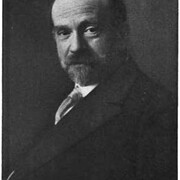Pío Baroja (1872–1956)
Author of The Tree of Knowledge
About the Author
Pio Baroja, whose works were admired by Ernest Hemingway, was one of Spain's foremost twentieth-century novelists. A socially conscious writer whose mission was to expose injustices, Baroja chose as central characters those who live outside society-bohemians, vagabonds, anarchists, degenerates, and show more tormented intellectuals. In The Restlessness of Shanti Andia (1911), Baroja uses Basque sailors as protagonists to dramatize his view of life as a constant struggle for survival and to present a shipboard world that functions outside society's laws. In The Tree of Knowledge (1911), medical student Andres Hurtado sees his intelligence as a disease and an incapacitating disgrace. Baroja's view that the concepts of beginning and end are human inventions to satisfy unattainable desires for meaning influences the form of his novels, often a series of episodes without cause and effect that end with unresolved problems. Baroja studied medicine, a discipline reflected in his works by an interest in the pathological. During the 1920s he was popular in the United States, where many of his novels appeared in translation. In 1936 he was elected to the Spanish Academy. Franco later banned all but one of his nearly 100 books, but Baroja continued to live and write, although less assertively, in Spain until his death. (Bowker Author Biography) show less
Series
Works by Pío Baroja
La Raza / The Race: La dama errante. La ciudad de la niebla. El arbol de la ciencia. / The wandering lady. The city of… (2006) 10 copies
Memorias de un hombre de acción II 4 copies
Mis mejores páginas 4 copies
La senda dolorosa (novela) 3 copies
Memorias de un hombre de acción: La ruta del aventurero (Volume 6) (Spanish Edition) (2018) 3 copies
Las mascaradas sangrientas 3 copies
La Obra De Pello Yarza 2 copies
Las mascaradas sangrientas novela 2 copies
Allegro final y otras cosas 2 copies
Obras Completas - Pío Baroja (2): Tomo II: Inventos, aventuras y mixtificaciones de Silvestre Paradox; Paradox, rey;… (1996) 2 copies
Adiós a la bohemia! ; Arlequín, mancebo de botica, o, Los pretendientes de Colombina ; El horroroso crimen de… (1998) 2 copies
Sedm záhad 2 copies
Las figuras de cera novela 2 copies
Trilogías, I. (Índice: Tierra Vasca (La casa de Aizgorri. El mayorazgo de Labraz. Zalacaín el aenturero., La leyenda… (2009) 2 copies
VIDAS SOMBRIAS 2 copies
Los últimos románticos Novela 2 copies
Memorias de un hombre de acción 2 copies
EL Libro de la Ciencia 1 copy
El pais vasco 1953 1 copy
Humano enigma Novela 1 copy
Lucha por la vida, La 1 copy
LA BUSCA 1 copy
Reportajes 1 copy
Obras completas tomo 2 1 copy
Obras completas tomo 3 1 copy
Paseos por Madrid 2022 1 copy
Colección Pío Baroja 1 copy
EL MAYORAZGO DE LABRAZ 1 copy
LA CAZA DE AIZGORRI 1 copy
BAR Zalacaín el aventurero 1 copy
MIS MEJORES PÁGINAS 1 copy
Ο Παραδόξ βασιλιάς 1 copy
La dama de Urtubi : novela 1 copy
La Lucha por la vida 1 copy
Una crónica escandalosa 1 copy
La familiab de Errotacho 1 copy
La dama errarrante 1 copy
La feria de lo secretos 1 copy
El Prendiz de conspirador 1 copy
Las furias novela 1 copy
El veleta de gasteizar 1 copy
La noches del buen retiro 1 copy
La venta de mirabel 1 copy
Los confidentes audaces 1 copy
La senda dolorosa 1 copy
Las mascarada sangrientas 1 copy
Las figuras de cera 1 copy
La buaca 1 copy
Los visionarios 1 copy
Bagatelas de otoño 1 copy
La intuición y el estilo 1 copy
La via della perfezione 1 copy
Piratenbloed 1 copy
Personajes con oficio 1 copy
ciudad de la neblina 1 copy
Zalacaín, el aventurero 1 copy
Piratenbloed 1 copy
La Via Della Perfezione 1 copy
Obras completas 1 copy
El Diablo a bajo precio 1 copy
El País Vasco 1 copy
Páginas escogidas 1 copy
Zalacain l'avventuriero 1 copy
La leyenda de Juan de Alzate 1 copy
Las ciudades 1 copy
Boj o život 1 copy
La Casa del crimen : novela 1 copy
Itxasoa laño dago 1 copy
EL PAIS VASCO 1 copy
Obras Completas - Pío Baroja (8): Tomo VIII: Novelas: El puente de las ánimas; El hotel del cisne; Los enigmáticos;… (1996) 1 copy
Obras Completas - Pío Baroja (4): Tomo IV: Memorias de un hombre de acción: El amor, el dandysmo y la… (1948) 1 copy
Obras Selectas - Pio Baroja 1 copy
La leyenda de Juan de Alzate 1 copy
Intermedios 1 copy
Intermedio sentimental 1 copy
CHOPIN Y JORGE SAND 1 copy
Blasa's Tavern 1 copy
Associated Works
Tagged
Common Knowledge
- Canonical name
- Baroja, Pío
- Legal name
- Baroja y Nessi, Pío
- Birthdate
- 1872-12-28
- Date of death
- 1956-10-30
- Gender
- male
- Nationality
- Spain
- Birthplace
- Donostia, Espainia
- Place of death
- Madrid, Spain
- Places of residence
- Donostia, Espainia
Madrid, Spain - Awards and honors
- Miembro de la Real Academia Española (1935-1956)
Members
Reviews
Lists
Awards
You May Also Like
Associated Authors
Statistics
- Works
- 294
- Also by
- 3
- Members
- 3,667
- Popularity
- #6,901
- Rating
- 3.8
- Reviews
- 111
- ISBNs
- 467
- Languages
- 6
- Favorited
- 7


















